Mathematical-Reasoning
Question 1 |
Kind : _______ : : Often : Frequently (By word meaning)
A | Mean |
B | Type |
C | Cruel |
D | Kindly |
Question 2 |
In a 100 meters race, A beat B by 10 meter or 2 second. What is the speed of A?
A | 5 Km/h |
B | 10 Km/h |
C | 15 Km/h
|
D | 20 Km/h
|
Question 2 Explanation:
When A completes 100m, B is at 90m which is 10m behind.Now A beats B by 2 secs.
This means B takes 2 more seconds to complete the race
As B is 10m behind when A completes the race, so B takes 2 secs to complete 10m
Speed of B = 5m/s
Total time of B = 100/5 = 20 secs
Time of A = 20 - 2 = 18 seconds
Speed of A = 100/18 = 5.555
This means B takes 2 more seconds to complete the race
As B is 10m behind when A completes the race, so B takes 2 secs to complete 10m
Speed of B = 5m/s
Total time of B = 100/5 = 20 secs
Time of A = 20 - 2 = 18 seconds
Speed of A = 100/18 = 5.555
Question 3 |
The ratio of ages of two persons A and B is 3 : 4 and that of ages of B and C is 4 : 5. If the average of all three is 40 years, what is B’s age?
A | 20 years
|
B | 30 years |
C | 40 years
|
D | 50 years
|
Question 3 Explanation:
Ration of ages of three persons= A:B:C= 3:4:5
Average of three is 40 years
What is the B’s age=?
We can’t get more than 120 as their age because the average of 3 persons is 40.
B is elder than A and younger than C
= 20+40+60
= 120
Average = (120/3)=40
Average of three is 40 years
What is the B’s age=?
We can’t get more than 120 as their age because the average of 3 persons is 40.
B is elder than A and younger than C
= 20+40+60
= 120
Average = (120/3)=40
Question 4 |
Three pipes fill a tank in 4 hours. If two of them take 8 and 12 hours each to fill the tank, how many hours will the third pipe take to fill the tank?
A | 6 hours |
B | 15 hours |
C | 18 hours
|
D | 24 hours
|
Question 4 Explanation:
Three pipes fill a tank in 4 hours
P1 takes 8 hours and in one hour work is 1/8
P2 takes 12 hours and and in one hour work is 1/12
P3 takes x hours and and in one hour work is 1/x
Amount of work done by both p1 and p2=(⅛+1/12+1/x)=5/24+1/x
Now 1/x=1/4-5/24=6-5/24=1/24
P3 will take 24 hours to fill the tank
P1 takes 8 hours and in one hour work is 1/8
P2 takes 12 hours and and in one hour work is 1/12
P3 takes x hours and and in one hour work is 1/x
Amount of work done by both p1 and p2=(⅛+1/12+1/x)=5/24+1/x
Now 1/x=1/4-5/24=6-5/24=1/24
P3 will take 24 hours to fill the tank
Question 5 |
In a park A, B, C, D, E and F are sitting. C is the brother of D’s husband and son of A. F is the daughter of D and sister of E.
A) E is the grandson of A
B) F is the daughter of C
C) B is the father of F
D) There are one son and one daughter in the group
E) C is the uncle of E
Choose the correct answer from the options given below:
A) E is the grandson of A
B) F is the daughter of C
C) B is the father of F
D) There are one son and one daughter in the group
E) C is the uncle of E
Choose the correct answer from the options given below:
A | (A), (B) and (C) only
|
B | (A), (C) and (E) only |
C | (B), (D) and (E) only |
D | (B), (C) and (D) only
|
Question 5 Explanation:
Input’s:
C is the brother of D’s husband and son of A
F is the daughter of D
F is sister of E
B=? [ Hint: D’s Husband ]
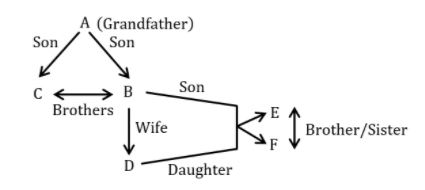
C is the brother of D’s husband and son of A
F is the daughter of D
F is sister of E
B=? [ Hint: D’s Husband ]

Question 6 |
A is the father of B and C is the son of D. E is the brother of A. B is the sister of C. How is D related to E?
A | Daughter |
B | Brother |
C | Brother in Law |
D | Sister in Law |
Question 6 Explanation:

Question 7 |
Pointing towards a picture, Ramesh said, “That picture is of the sister of the grandson of the father of my maternal uncle”. How is that lady in the picture related to Ramesh?
A | Mother’s sister |
B | Cousin (maternal brother) |
C | Cousin (maternal sister) |
D | Father’s sister |
Question 7 Explanation:
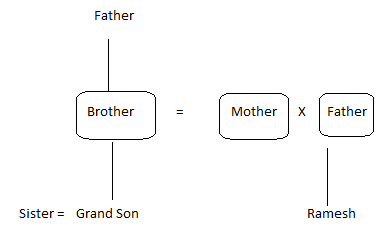
Question 8 |
If ‘CONTEMPORARY’ is coded as NOCTEMROPARY then ‘BODARDSITAND’ is the code of which letter?
A | DOBARDTISAND |
B | BODDRASITDNA |
C | DOBDRATISDNA |
D | DOBARDSITAND |
Question 8 Explanation:
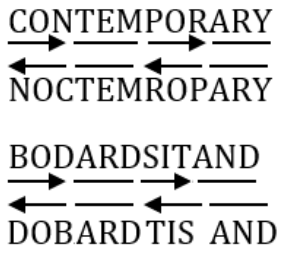
Question 9 |
Find the number which does not fit into the series
8 12 20 32 50 68
A | 20 |
B | 32 |
C | 68 |
D | 50 |
Question 9 Explanation:

Question 10 |
Complete the following series
4, 27, 256, 3125, _____
A | 46656 |
B | 6250 |
C | 800000 |
D | 1024 |
Question 10 Explanation:
22 = 4
33 = 27
44 = 256
55 = 3125
66 = 46656
33 = 27
44 = 256
55 = 3125
66 = 46656
Question 11 |
A Businessman purchases an item at a certain price and marks its price up by 30%. He sells the item at a certain discount on markup price and makes a net profit of 4% on the whole transaction. Find the discount given by a businessman on markup price.
A | 10 |
B | 15 |
C | 26 |
D | 20 |
Question 12 |
Find the missing number.
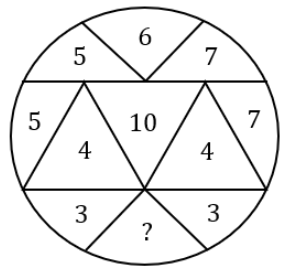
A | 14 |
B | 10 |
C | 9 |
D | 3 |
Question 13 |
If 5% income of P is equal to 15% income of Q and 10% income of Q is equal to 20% income of R. If income of R is ₹ 2000, then what are the incomes of P and Q respectively?
A | ₹ 4000 and ₹ 8000 |
B | ₹ 12000 and ₹ 4000
|
C | ₹ 15000 and ₹ 5000 |
D | ₹ 18000 and ₹ 6000 |
Question 13 Explanation:
5%P = (15/100)*Q
(10/100)*Q = (20/100)*R
(20/100)*2000
=4000
(10/100)*Q = 4000
Q = 4000
(5/100)*P = (15/100)*4000
=600
P = (600*100)/5
P=12000
(10/100)*Q = (20/100)*R
(20/100)*2000
=4000
(10/100)*Q = 4000
Q = 4000
(5/100)*P = (15/100)*4000
=600
P = (600*100)/5
P=12000
Question 14 |
Directions for question number 23 to 26:
Answer the questions on the basis of the data given below:
O is X’s father
Y is Z’s mother
P is O’s mother
X is Z’s sister
Q23. If P has a daughter Q, then how is Q related to Z?
A | Aunt |
B | Mother |
C | Sister |
D | Daughter |
Question 14 Explanation:
If P has a daughter Q, then Q related to Z is Aunt.
Question 15 |
Directions for question number 23 to 26:
Answer the questions on the basis of the data given below:
O is X’s father
Y is Z’s mother
P is O’s mother
X is Z’s sister
Q24. How is Y related to O?
A | Wife |
B | Sister |
C | Mother |
D | Daughter |
Question 15 Explanation:
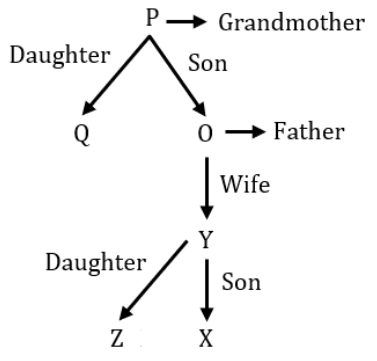
Y related to O is wife.
Question 16 |
Directions for question number 23 to 26:
Answer the questions on the basis of the data given below:
O is X’s father
Y is Z’s mother
P is O’s mother
X is Z’s sister
Q25. How is O related to Z?
A | Brother |
B | Cousin |
C | Father |
D | Uncle |
Question 16 Explanation:
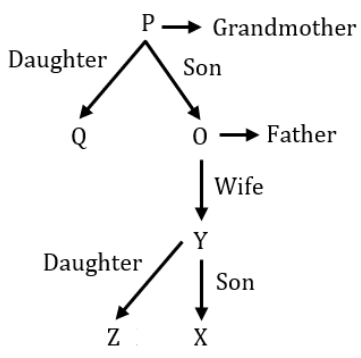
O related to Z is father.
Question 17 |
Directions for question number 23 to 26:
Answer the questions on the basis of the data given below:
O is X’s father
Y is Z’s mother
P is O’s mother
X is Z’s sister
Q26. How is P related to X?
A | Mother |
B | Grandmother |
C | Sister |
D | Daughter |
Question 17 Explanation:

P related to X is Grandmother.
Question 18 |
14, 28, 20, 20, 40, 32, 64, _______
A | 52 |
B | 56 |
C | 96 |
D | 128 |
Question 18 Explanation:

Question 19 |
5 16 49 104 181 ______
A | 271 |
B | 298 |
C | 280 |
D | 281 |
Question 19 Explanation:

Question 20 |
In a certain code, ‘CONSIDER’ is written as RMNBSFEJ, how is ‘MONOPOLY’ written in that code?
A | LNMNZMPQ |
B | NMNLZMPQ |
C | POPNXKNO |
D | NMNLXKNO |
Question 20 Explanation:
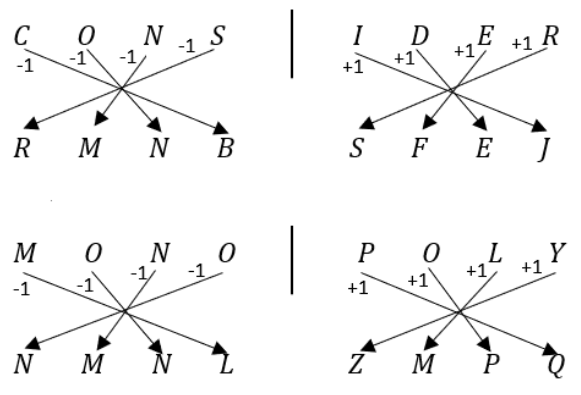
Question 21 |
Ram can do a piece of work in 5 days, and Sham can do the same in 10 days. With the help of Karan, they finished the work in 2 days. How many days would it take Karan to do the work?
A | 5 days |
B | 10 days |
C | 15 days |
D | 20 days |
Question 21 Explanation:
Ram can do a piece of work = 5 days
Sham can do a piece of work = 10 days
Ram + Sham + Karan = 2 days
Karan= 5 days
Sham can do a piece of work = 10 days
Ram + Sham + Karan = 2 days
Karan= 5 days
Question 22 |
Considering 5 as the 1st element in the sequence 5, 11, 23, 47. What is the 6th element in the sequence?
A | 191 |
B | 172 |
C | 342 |
D | 106 |
Question 22 Explanation:

Question 23 |
₹ 1000 doubled in 10 years when compounded annually. How many more years will it take to get another ₹ 2000 compound interest?
A | 5 years |
B | 10 years |
C | 3 years |
D | 4 years |
Question 23 Explanation:
₹ 1000 invested in compound interest becomes ₹ 2000 in 10 years.
The amount will double again in another 10 years.
The amount will become ₹ 2000 in another 10 years.
So, to earn another ₹ 2000 interest, it will take another 10 years.
The amount will double again in another 10 years.
The amount will become ₹ 2000 in another 10 years.
So, to earn another ₹ 2000 interest, it will take another 10 years.
Question 24 |
A man walks 12 km towards south and then 7 km towards north. From here he walks 5 km
towards his left. How far and in which direction is the man with reference to his standing
point?
A | 5km, North-west |
B | 5km, south-west |
C | 5√2, south-west |
D | 5√2, south-east
|
Question 24 Explanation:
Walks 12 km south → (Position: 12 km south)
Walks 7 km north → (Net movement: 12−7=5 km south)
Walks 5 km towards his left
Facing north, left is west → (Moves 5 km west)
The man is 5 km south and 5 km west from the starting point.
To find the straight-line distance from the starting point,
distance=√(52+52)=5√2
Walks 7 km north → (Net movement: 12−7=5 km south)
Walks 5 km towards his left
Facing north, left is west → (Moves 5 km west)
The man is 5 km south and 5 km west from the starting point.
To find the straight-line distance from the starting point,
distance=√(52+52)=5√2
Question 25 |
Find the number that can replace question mark (?) in the series given below
21, 22, 26, 35, 51, ?
21, 22, 26, 35, 51, ?
A | 62 |
B | 66 |
C | 86 |
D | 76 |
Question 26 |
If (L)M represents a number L in base-M number system, then identify the correct ascending order of the following numbers A-D when converted to decimal number system.
A, (11011.11)2
B, (131.2)4
c. (25.5)8
D. (16.6)16
Choose the correct answer from the options given below:
A, (11011.11)2
B, (131.2)4
c. (25.5)8
D. (16.6)16
Choose the correct answer from the options given below:
A | C, D,B,A |
B | C,D,A,B |
C | A,C,D,B |
D |
B,A,C,D
|
Question 27 |
In a certain coding scheme, 'DELHI" is coded as 5613910, then how is "MUMBAI" coded in this scheme?
A | 1422143210 |
B | 132113219 |
C | 122012108 |
D | 1523154311 |
Question 28 |
Match the LIST-I with LIST-II
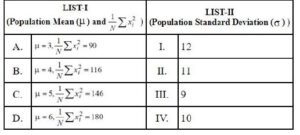
Choose the correct answer from the options given below:

Choose the correct answer from the options given below:
A | A-I, B-II, C-III, D-lV |
B | A-II, B-III, C-IV, D-l |
C | A-III, B-lV, C-II, D-l |
D | A-IV, B-III, C-II, D-l
|
Question 29 |
If 7: X = 17.5: 22.5, find the value of X.
A | 9 |
B | 12 |
C | 15 |
D | 8 |
Question 30 |
Find the value of the given expression correct upto 2 decimal places.
(0.05*0.05*0.05+0.04*0.04*0.04) /(0.05*0.05-0.05*0.04+0.04*0.04)
(0.05*0.05*0.05+0.04*0.04*0.04) /(0.05*0.05-0.05*0.04+0.04*0.04)
A | 0.19 |
B | 0.09 |
C | 0.90 |
D | 0.85 |
Question 31 |
Arrange the following fractions in increasing order :
A)12/17
B)13/19
C)8/11
D)16/23
Choose the correct answer from the options given below :
A)12/17
B)13/19
C)8/11
D)16/23
Choose the correct answer from the options given below :
A | (B), (D), (A), (C) |
B | (B), (A), (C), (D) |
C | (D), (A), (B), (C) |
D | (D), (B), (C), (A) |
Question 32 |
Identify the numbers that occurs in the series 1,7,17,31,49,...................
A)74
B)95
C)97
D)127
E)161
Choose the correct answer from the options given below :
A)74
B)95
C)97
D)127
E)161
Choose the correct answer from the options given below :
A | (A),(B),(C) only
|
B | (C),(D),(E) only |
C | (E),(B),(A) only
|
D | (C),(D),(B) only
|
Question 33 |
Match List-I with List-II:
List-I (Word) List-II (Unique Code)
(A) Q U A K E (I) K T F U L
(B) O F T E N (II)V H Q D U V H Q D U
(C) P E A C H (III) I E Y O U
(D) D R I V E (IV) J U Y W R
Choose the correct answer from the options given below:
List-I (Word) List-II (Unique Code)
(A) Q U A K E (I) K T F U L
(B) O F T E N (II)V H Q D U V H Q D U
(C) P E A C H (III) I E Y O U
(D) D R I V E (IV) J U Y W R
Choose the correct answer from the options given below:
A | (A)-(I), (B)-(III), (C)-(II), (D)-(IV) |
B | (A)-(I), (B)-(IV), (C)-(III), (D)-(II) |
C | (A)-(III), (B)-(I), (C)-(IV), (D)-(II) |
D | (A)-(IV), (B)-(II), (C)-(I), (D)-(III)
|
Question 34 |
In a race of 500 m run, A beats B by 20 m and C by 80 m. If B and C are running another race of 100 m with exactly same speed as before, then b how many meters will B and C ?
m
A | 10.0m |
B | 8.5m |
C | 15.0m |
D | 12.5m |
Question 35 |
A person sold an item at a loss of 7%. Had he sold the item at a gain of 7.5%, he would have received Rs. 87 more than his selling price. The cost price of the item is:
A | Rs. 500 |
B | Rs. 550 |
C | Rs. 600 |
D | Rs. 650
|
Question 36 |
A man walks 40 meter towards south. Then turning to his right he walks 40 meters again. Then he turns to his left and walks 20 meters. He again turns to his left and walks 40 meters. How far is the man now from his starting point?
A | 60 meters |
B | 40 meters |
C | 100 meters |
D | 80 meters |
Question 37 |
Introducing a boy, a girl said, "He is the son of the daughter of the father of my uncle". How is the boy related to the girl?
A | Uncle |
B | Nephew |
C | Cousin |
D | Brother-in-law |
Question 38 |
Find the wrong term in the given series: 6,11,I8, 27,34,51,66,83
A | 34 |
B | 51 |
C | 83 |
D | 11 |
Question 39 |
Find the average of the squares of the consecutive odd numbers from 1 to 21
A | 162 |
B | 161 |
C | 159 |
D | 160 |
Question 40 |
At what percent of compound interest per annum, a sum of money will double in 14 years ?
A | 4% |
B | 5% |
C | 6% |
D | 6.5% |
Question 41 |
Two numbers are in the ration of 7:8.If the difference between the numbers is 30,then find the numbers
A | 215,245
|
B | 205,235
|
C | 220,250
|
D | 210,240 |
Question 42 |
Two shopkeepers 'A' and 'B' sell certain kind of machines at the same list price. However, shopkeeper 'A' allows two successive discounts of 20% and 15% and shopkeeper 'B' allows two successive discounts of 10% and 25%.Which of the following statements is correct?
A | A offers more discount
|
B | B offers more discount
|
C | Both A and B offers same discount
|
D | A offers 35% discount and B offers 30% discount |
Question 43 |
Insert the missing number :
8 24 12 ? 18 54
8 24 12 ? 18 54
A | 26 |
B | 24 |
C | 36 |
D | 32 |
Question 43 Explanation:

Question 44 |
January 1, 1995 was Sunday. What day of the week lies on January 1, 1996 ?
A | Sunday |
B | Monday |
C | Saturday |
D | None of these |
Question 44 Explanation:
No. of odd days between Jan 1st 1995 to Jan 1st 1996 is 1.
∴ Jan 1st, 1996 is Monday.
∴ Jan 1st, 1996 is Monday.
Question 45 |
The sum of a positive number and its reciprocal is twice the difference of the number and its reciprocal. The number is :
A | √2 |
B | 1/ √2 |
C | √3 |
D | 1/ √3 |
Question 45 Explanation:
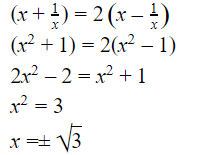
Question 46 |
In a certain code, ROUNDS is written as RONUDS. How will PLEASE will be written in the same code :
A | L PA E S E |
B | P L A E S E |
C | L P A E E S |
D | P L A S E E |
Question 46 Explanation:

Question 47 |
At what time between 5.30 and 6.00 will the hands of an clock be at right angles ?
A | 43 (5/11) min. past 5 |
B | 43 (7/11) min. past 5 |
C | 40 min. past 5 |
D | 45 min past 5 |
Question 47 Explanation:

Question 48 |
The next term in the series ABD, DGK, HMS, MTB ... is:
A | SBL |
B | PSK |
C | RUH |
D | NSA |
Question 48 Explanation:

Question 49 |
In certain code, “COVALENT” is code as BWPDUOFM. The code of “ELEPHANT” will be:
A | QMUBIADH |
B | QFMFUOBI |
C | EPHNTEAS |
D | MFUIQRTW |
Question 49 Explanation:
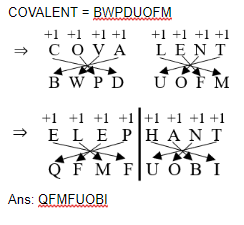
Question 50 |
In the series 1, 6, 15, 28, 45 ... the next term will be:
A | 76 |
B | 56 |
C | 84 |
D | 66 |
Question 50 Explanation:

Access subject wise (1000+) question and answers by becoming as a solutions adda PRO SUBSCRIBER with Ad-Free content
Register Now
You have completed
questions
question
Your score is
Correct
Wrong
Partial-Credit
You have not finished your quiz. If you leave this page, your progress will be lost.
Correct Answer
You Selected
Not Attempted
Final Score on Quiz
Attempted Questions Correct
Attempted Questions Wrong
Questions Not Attempted
Total Questions on Quiz
Question Details
Results
Date
Score
Hint
Time allowed
minutes
seconds
Time used
Answer Choice(s) Selected
Question Text
Need more practice!
Keep trying!
Not bad!
Good work!
Perfect!
